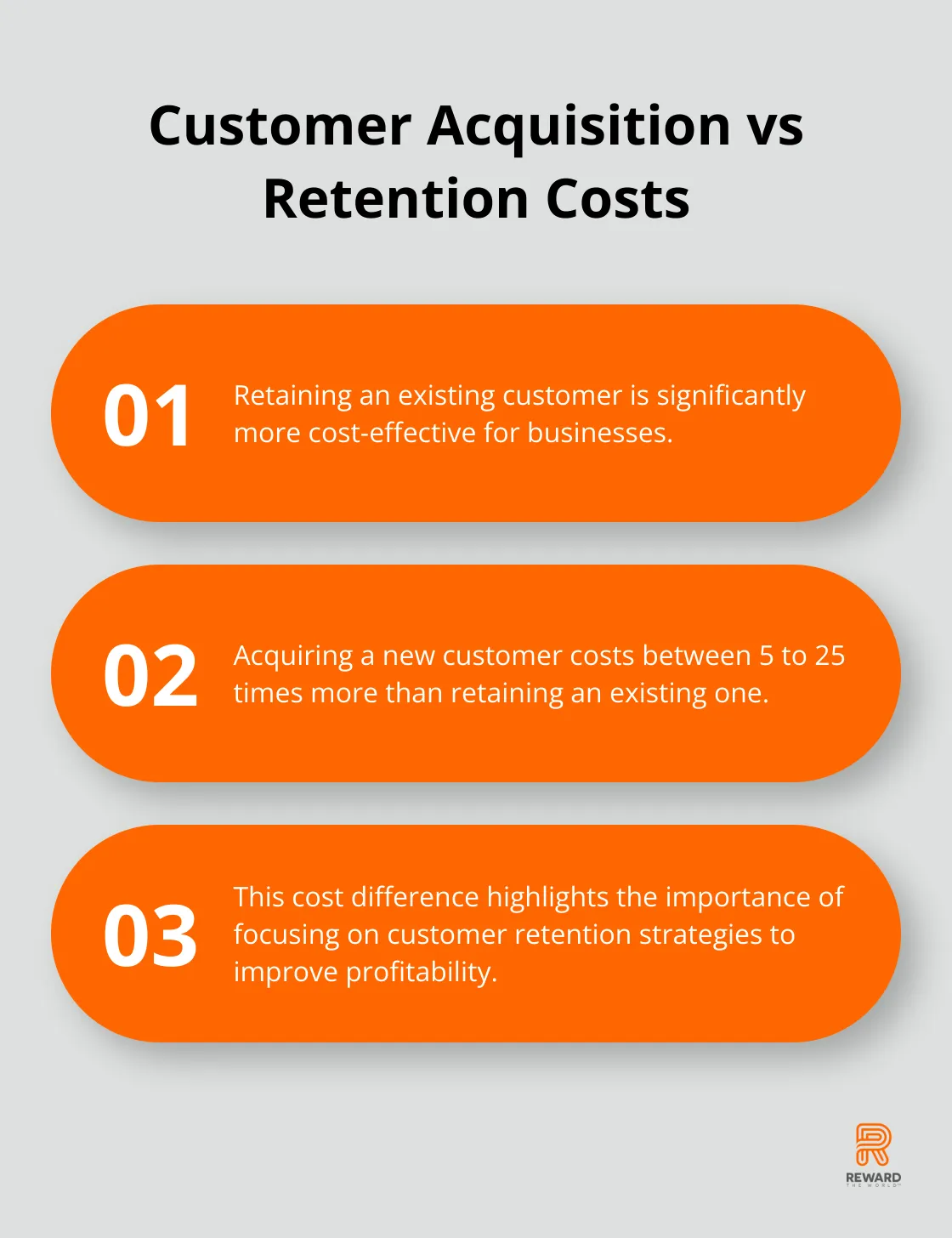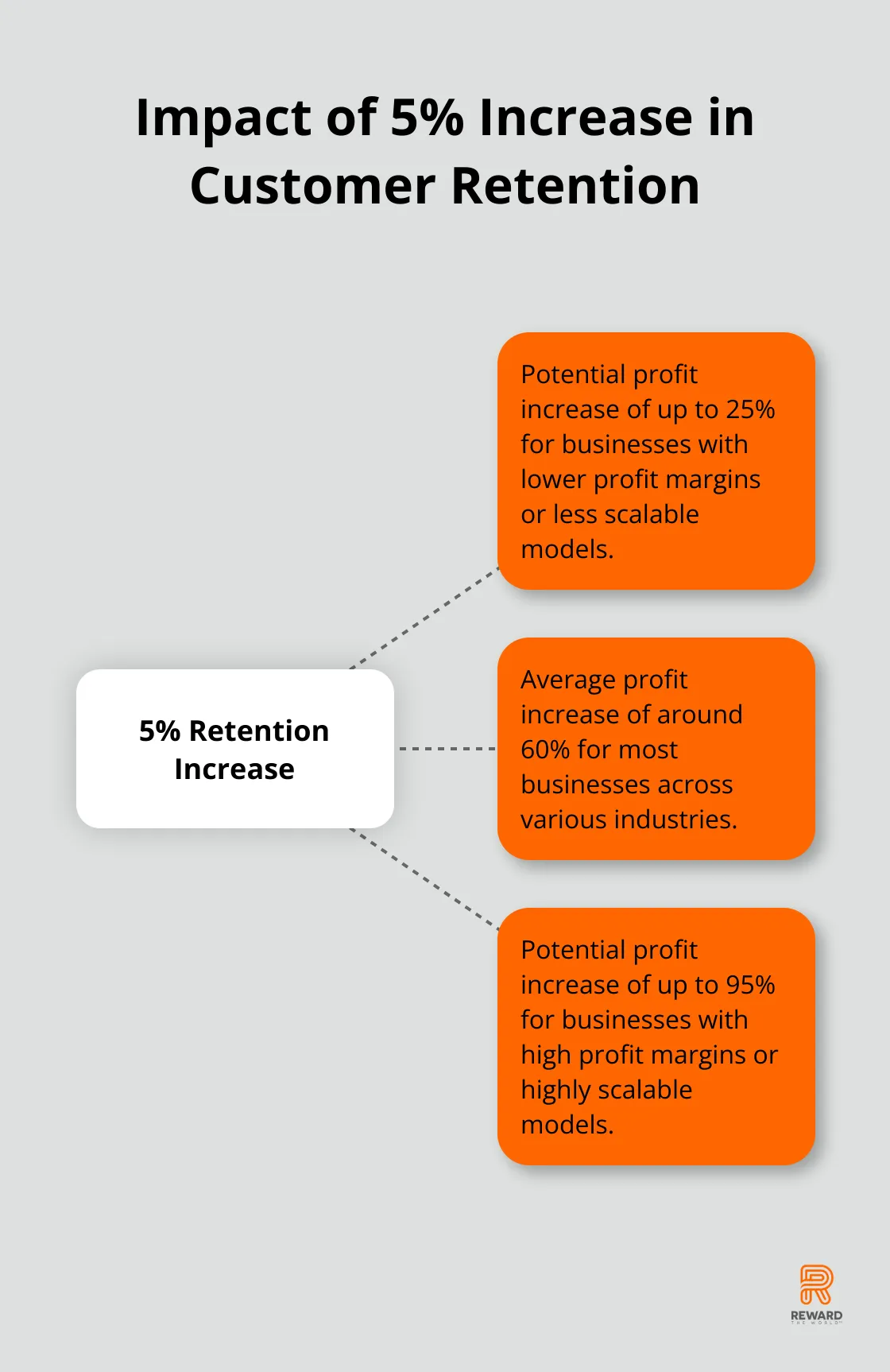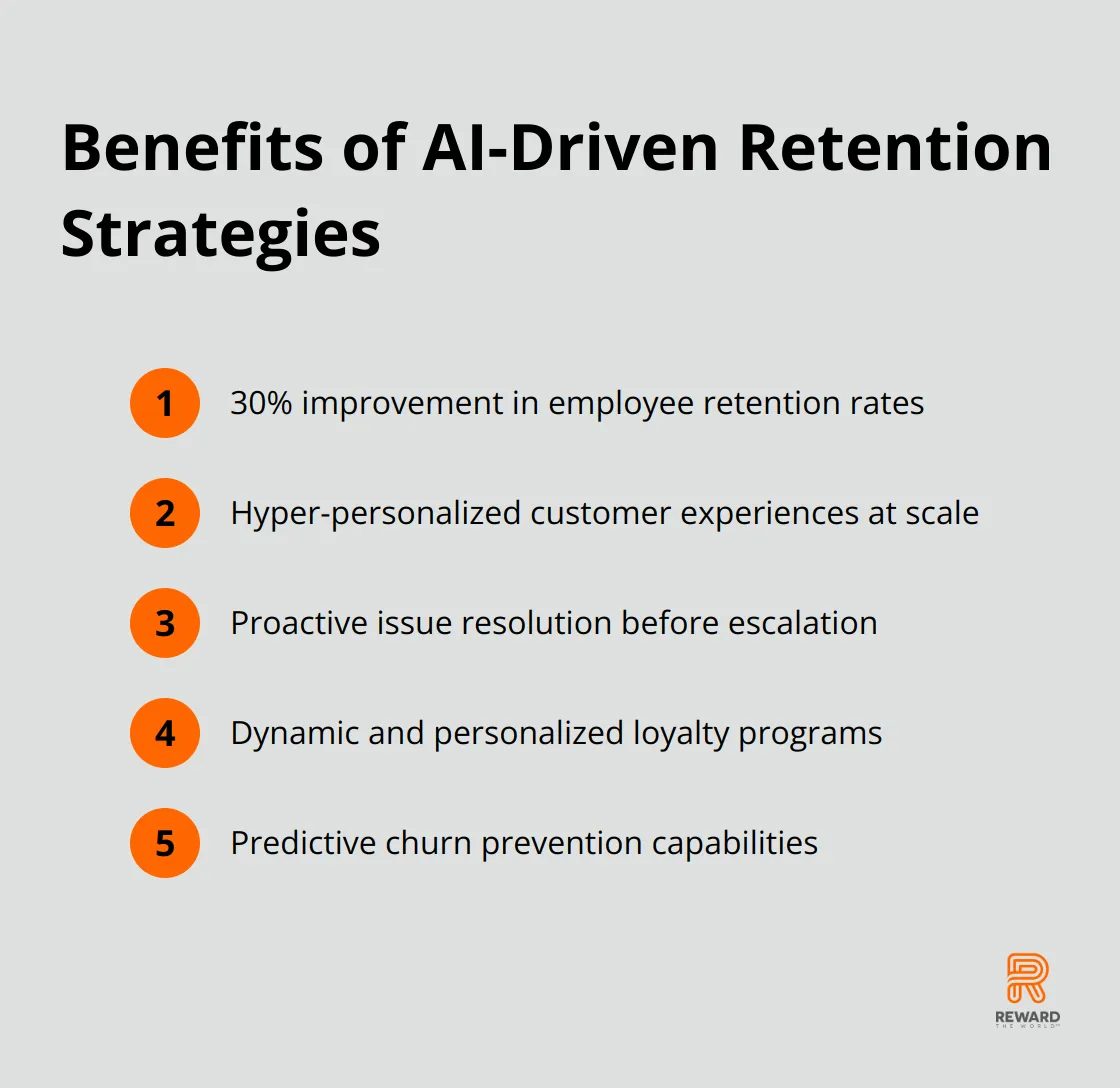
At Reward the World, we’ve seen how customer defection can significantly impact businesses in the digital age.
Losing customers is costly, but with the right tools, it’s preventable.
Artificial Intelligence (AI) has emerged as a game-changer in customer retention strategies, offering powerful predictive churn capabilities.
In this post, we’ll explore how AI can help businesses keep their customers loyal and satisfied before they even think about leaving.
Why Do Customers Leave?
The High Cost of Customer Churn
In today’s fast-paced digital landscape, customer defection poses a critical threat to businesses. Customer defection (or churn) occurs when a customer stops using a company’s products or services and switches to a competitor. This phenomenon can devastate a company’s bottom line.
Harvard Business Review reports that acquiring a new customer costs 5 to 25 times more than retaining an existing one. This stark reality underscores the importance of keeping current customers happy and engaged. Furthermore, Bain & Company found that a mere 5% increase in customer retention can boost profits by an impressive 25-95%. These numbers highlight the significant financial impact of customer defection on businesses across industries.

Root Causes of Customer Exodus
Understanding why customers leave is essential for developing effective retention strategies. Common reasons for customer churn include:
- Poor customer service: Nearly 80% of consumers will forgive a bad experience at a company whose customer service they rate as “very good,” but only one in five will do so for those rated as “very poor.”
- Lack of personalization: In an era of tailored experiences, generic approaches often fall flat.
- Competitor offerings: Better prices, features, or overall value from rivals can lure customers away.
- Product dissatisfation: Failing to meet customer expectations or address pain points leads to disengagement.
- Changing needs: As customer requirements evolve, businesses that don’t adapt risk losing relevance.
AI: The Game-Changer in Customer Retention
AI emerges as a powerful ally in the fight against customer churn. Machine learning algorithms and predictive analytics enable AI to analyze vast amounts of customer data to identify patterns and predict potential defectors before they jump ship.
AI can:
- Analyze customer behavior patterns to flag early warning signs of dissatisfaction.
- Personalize communication and offers based on individual preferences and history.
- Automate and optimize customer service interactions for faster, more effective problem resolution.
- Predict which customers are most likely to churn, allowing for targeted retention efforts.
The Power of Proactive Engagement
One of the most significant advantages of AI in customer retention is its ability to enable proactive engagement. AI allows businesses to identify and address potential issues before they escalate, rather than waiting for customers to voice their concerns (or worse, silently switch to a competitor).
For example, AI can detect changes in purchasing patterns or engagement levels that might indicate a customer is considering leaving. This early warning system allows companies to intervene with targeted offers, personalized communication, or proactive problem-solving, potentially saving the customer relationship before it’s too late.
AI-Driven Personalization: The Key to Customer Loyalty
AI-powered personalization takes customer retention to new heights. By analyzing individual customer data (including purchase history, browsing behavior, and demographic information), AI can create highly tailored experiences that resonate with each customer.
This level of personalization extends beyond simple product recommendations. AI can customize everything from email subject lines to the timing of communications, ensuring that each interaction feels relevant and valuable to the customer.
As we move into the next section, we’ll explore how AI-powered predictive analytics revolutionizes customer retention strategies, providing businesses with unprecedented insights into customer behavior and preferences. Real-world case studies illustrate successful implementations, highlighting the effectiveness of AI-driven predictive models in reducing churn.
How AI Predicts Customer Defection
At Reward the World, we witness AI’s transformative impact on customer retention strategies. Machine learning and predictive analytics now enable businesses to anticipate and prevent customer defection with remarkable accuracy.
Analyzing Customer Behavior Patterns
AI’s ability to process vast amounts of customer data allows businesses to identify patterns that human analysts often overlook. These systems analyze information from various touchpoints, including purchase history, website interactions, customer service logs, and social media activity.
AI’s capabilities extend to writing SQL, building predictive and forecasting models, running sentiment analysis, and visualizing data, all of which contribute to more effective customer insights.
Identifying Early Warning Signs
AI systems excel at spotting early indicators of customer dissatisfaction. Key red flags include:
- Reduced engagement: AI monitors metrics like login frequency, platform time, and feature usage. A sudden drop in these areas often signals waning interest.
- Altered purchase patterns: Unexpected changes in buying behavior (e.g., reduced order frequency or lower average order value) can indicate a customer’s consideration of alternatives.
- Increased support requests: A surge in customer service interactions, especially for similar issues, may suggest growing frustration.
- Negative sentiment in communications: AI-powered natural language processing detects shifts in tone and sentiment in customer emails, chat logs, and social media posts.
Implementing Real-Time Monitoring
AI’s true power in customer retention lies in its real-time insight provision. Unlike traditional methods relying on periodic reports, AI systems continuously monitor customer behavior and update risk assessments instantly.
This proactive approach helps businesses respond swiftly to potential churn risks. Real-time AI-powered analytics can accurately forecast churn and offer strategies for preventing customer loss, ultimately improving retention and loyalty.
Utilizing Predictive Scoring
AI doesn’t just identify at-risk customers; it assigns predictive scores to prioritize retention efforts. These scores consider multiple factors to estimate churn likelihood and potential value loss if the customer defects.
Crafting Personalized Retention Strategies
Once AI identifies at-risk customers, it suggests personalized retention strategies. These might include targeted offers, proactive outreach, or customized content designed to re-engage the customer.
Increasing customer retention by just 5% can lead to a profit increase of 25% to 95%, according to a study by Bain & Company. This underscores the importance of implementing effective AI-driven retention strategies.

As we move forward, we’ll explore how businesses can implement these AI-driven insights to create effective retention strategies that not only reduce churn but also strengthen customer relationships for long-term loyalty and growth.
How AI Transforms Your Retention Strategy
At Reward the World, we observe the revolutionary impact of AI-driven retention strategies on customer relationships. This chapter explores how businesses can use AI to maintain customer engagement and loyalty.
Hyper-Personalization at Scale
AI allows businesses to provide personalized experiences to millions of customers simultaneously. Through analysis of extensive data, AI creates detailed customer profiles and predicts individual preferences accurately.
An e-commerce platform using AI might notice a customer’s frequent browsing of running shoes without purchase. The AI could then initiate a personalized email with a special offer on running shoes, including content about selecting appropriate running gear. This timely, personalized approach can significantly increase engagement and reduce customer defection likelihood.
Proactive Issue Resolution
AI’s ability to anticipate and resolve issues before escalation stands as one of its most powerful applications in customer retention. AI systems monitor customer behavior patterns and identify potential problems early.
A telecommunications company might use AI to analyze network usage data and customer service logs. If the AI detects a pattern of dropped calls in a specific area, it automatically alerts the technical team and initiates proactive outreach to affected customers. This approach resolves issues quickly and demonstrates the company’s commitment to customer experience.
AI-Powered Loyalty Programs
AI transforms traditional loyalty programs by making them more dynamic and personalized. An AI-driven loyalty program adapts rewards based on individual customer preferences and behaviors.
Instead of offering generic points, the system might provide a frequent traveler with priority boarding on their next flight or a music enthusiast with exclusive concert tickets. AI can also optimize the timing and delivery of rewards. For a customer who typically makes purchases on weekends, the AI might send a special offer on Friday afternoon to maximize engagement.
Predictive Churn Prevention
AI’s ability to predict which customers risk churning stands as perhaps its most valuable application in retention strategies. Through analysis of factors such as purchase history, customer service interactions, and engagement levels, AI assigns a churn risk score to each customer.
This predictive capability enables businesses to intervene before a customer decides to leave. For high-risk customers, the AI might initiate a series of re-engagement campaigns, special offers, or even direct outreach from a customer service representative.
Continuous Optimization
AI-driven retention strategies learn and improve over time. As the AI system gathers more data and observes the outcomes of different interventions, it refines its predictions and recommendations.
This continuous optimization ensures that retention strategies become more effective over time, leading to higher customer satisfaction and loyalty rates. According to a recent study by Gartner, organizations that adopt AI-driven retention policies see a 30% improvement in employee retention rates.

Implementing AI-driven retention strategies requires commitment to data collection and analysis, as well as willingness to adapt business processes. However, the potential rewards are substantial. Businesses that successfully leverage AI for customer retention can expect significant improvements in customer lifetime value, reduced churn rates, and ultimately, stronger bottom-line results.
Final Thoughts
AI revolutionizes customer retention strategies, offering businesses powerful tools to prevent defection. Predictive churn models identify at-risk customers, enabling companies to intervene effectively and strengthen relationships. As AI technology evolves, we expect more sophisticated retention strategies, including advanced natural language processing and hyper-personalized loyalty programs.
Businesses must invest in robust data collection and analysis capabilities to leverage AI for customer loyalty. Integration of AI into existing customer relationship management systems ensures seamless implementation of AI-driven strategies. Staff training on AI-generated insights interpretation remains vital in building and maintaining customer relationships.
Reward the World leverages advanced AI capabilities to deliver personalized rewards and incentives, helping businesses increase customer loyalty. Our platform offers a scalable solution for businesses of all sizes looking to harness the power of AI for customer retention (available in 15 languages). The future of customer loyalty is here, and AI powers it.
